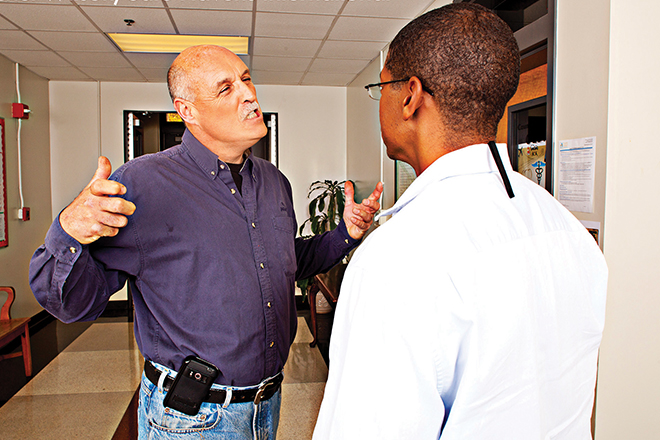Article by Michael Dorn, Safe Havens International
Feature image: This photo from a scenario training shows a school employee encountering an irate parent. Most school homicides start with lower levels of aggression that escalate into weapons violence. Photo courtesy of Safe Havens International.
“Options-based” active-shooter training programs, which encourage school staff to choose among crisis response options, have become extremely popular in recent years. However, there is considerable disagreement among experts about the effectiveness of these programs. Furthermore, the training has resulted in an alarming number of workers’ compensation claims and pending litigation against school and police officials resulting from injuries.
While I do not disagree with the basic options taught in some of these programs, I am concerned with the significant distance between what trainers think people are learning and what trainees actually do under stress. Though there are reports of at least two school employees who appear to have successfully used this type of training to interrupt school shootings and save lives, other educators have died while unsuccessfully attempting to physically stop people with guns.
To understand the effects of such training, Safe Havens International conducted fidelity testing to see if training programs had the desired outcomes. We ran 8,000 one-on-one controlled video and audio simulations at independent, faith-based and public schools in 45 states. In these simulations, a staff member responded to a variety of video and audio scenarios. Analysts typically ran six scenarios with each participant, who would have 30 seconds to verbally respond, a typical time frame in which to take life-saving action.
Here are findings regarding school personnel who had completed options-based active-shooter training programs or viewed the video “Run. Hide. Fight.”:
- They generally performed at lower levels than those who had not been trained. On average, they misjudged almost twice as many critical action steps as educators who had not received the training and used more common sense actions.
- They were more likely to attack anyone depicted as having a gun, regardless of context. For example, in simulations, they opted to attack not only a man taking hostages but also a student threatening suicide, holding a cocked pistol to his temple with his finger on the trigger.
- They frequently opted to evacuate and/or run when doing so would clearly increase danger. Running has been proven to dramatically slow evacuation and cause mass casualties in certain situations, such as overcrowded doorways, stairwells and gated outdoor areas.
- They were unprepared for the types of school crisis events (not active-shooter events) that result in the majority of deaths on K-12 campuses.
The manner in which options-based active-shooter programs are taught can significantly impact the likelihood that faculty and staff will react in ways that harm more than help. For example, such trainings sometimes encourage victims to run if an attacker breaches a locked classroom door, enters the room and attempts to kill occupants. However, this scenario is not only highly unlikely (it has happened in only one K-12 shooting to date in the U.S.), but it also predisposes many trainees to evacuate when they have no idea where gunshots are coming from.
Most likely, workers’ compensation, litigation and deaths resulting from unsound training approaches will eventually drive improvement in how active assailant responses are taught and tested. In the meantime, we advise schools that have adopted these approaches to teach personnel when the presented options can increase danger. We also encourage post-training fidelity testing to verify that training has had desirable effects. Taking these steps can dramatically reduce the risks of serious injury or death, while providing options for better protecting students and staff.



